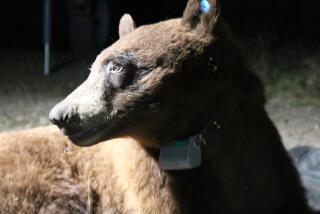Environmentalists want Chatsworth Nature Preserve left alone
- Share via
Jarron Lucas tromped through waist-high brush at the Chatsworth Nature Preserve, flipping over weathered boards.
“Let’s see if anyone’s home,” he said, lifting a plank. Coiled underneath was a reddish snake with dark brown cross bands on its neck. Lucas reached down and snatched the young red racer. “It’s just a baby,” he said as the slender 14-inch snake writhed in his hand. Male, too, he said, judging from the long tail.
A few yards away, he found a 4-foot adult female red racer thick as a broom handle. “It’s the little guy’s mamma,” Lucas said with a smile.
“You never know what you’re going to find out here,” Lucas, spokesman for the Southwest Herpetologists Society, said as he surveyed the brushy landscape tinged with the spicy scents of white sage and milkweed. “There’s no place like it in the city. We can’t afford to lose it.”
Photos: Chatsworth Nature Preserve
The herpetologists society, the San Fernando Valley Audubon Society and other environmental groups are concerned that Los Angeles’ plan to allow construction of 44 acres of wetlands and transfer control of the property from the Department of Water and Power to the Department of Recreation and Parks could inadvertently degrade the largely undeveloped area, which is rich in wildlife.
The 1,300-acre preserve in the northwestern San Fernando Valley is still a place where two-striped garter snakes, black-headed snakes and desert night snakes slither through willow forests and grasslands. Horned lizards and whiptail lizards skitter over sandy slopes. Worm salamanders cling to the moist stone walls of an old storm drain. After a heavy spring rain, ponds are black with toad tadpoles, which attract migrating shorebirds.
The herpetological community is still talking about a Western spadefoot toad recently discovered in a marsh at the preserve. Spadefoot toads, which get their name from a distinctive hard, black projection on each hind foot, had not been seen in the area for more than a decade.
Republic Services Inc. aims to establish 44 acres of riparian and wetland habitat within the property to mitigate the loss of similar habitat at its Sunshine Canyon Landfill near Sylmar. For now, the Department of Recreation and Parks plans to maintain the property in its natural state. But some local residents want the agency to build biking, hiking and equestrian trails, as well as wildlife viewing platforms.
Los Angeles City Councilman Mitchell Englander, whose district includes the preserve, said the environmentalists’ fears were misplaced. “I’m leading a parade to protect this preserve forever, and I’m asking them to join me,” he said. “As it stands, the DWP could sell this property for a graveyard, a golf course or a high-density apartment complex.”
By charter, the city Recreation and Parks Department can’t sell the parcel, Englander noted. “It would not be a recreational facility,” he said. “Instead, it would be used for docent-led tours and open to people and groups like the Sierra Club, the Audubon Society and schoolchildren.
“The only point we differ on is whether or not the mitigation would enhance the habitat.”
But that’s a big point to supporters of the preserve. “This place doesn’t need one thing done to it; it is fine just as it is,” said Lucas, a DWP reservoir keeper and tour guide at the preserve. “If the city’s plans go through, there’ll be nothing special left here in 20 years. It will turn into another Lake Machado.”
Lake Machado is best known as the swampy hide-out of Reggie, the abandoned alligator who eluded animal control officers for two years before being captured and sent to the Los Angeles Zoo. The 31-acre lake and surrounding Ken Malloy Harbor Regional Park are plagued by trash and unwanted alien species: bullfrogs, apple snails as big as baseballs and Florida banded water snakes.
“What we have right now is a functioning nature preserve teeming with wildlife,” said Mark Osokow, a board member of the San Fernando Valley Audubon Society.
Photos: Chatsworth Nature Preserve
More to Read
Sign up for Essential California
The most important California stories and recommendations in your inbox every morning.
You may occasionally receive promotional content from the Los Angeles Times.











